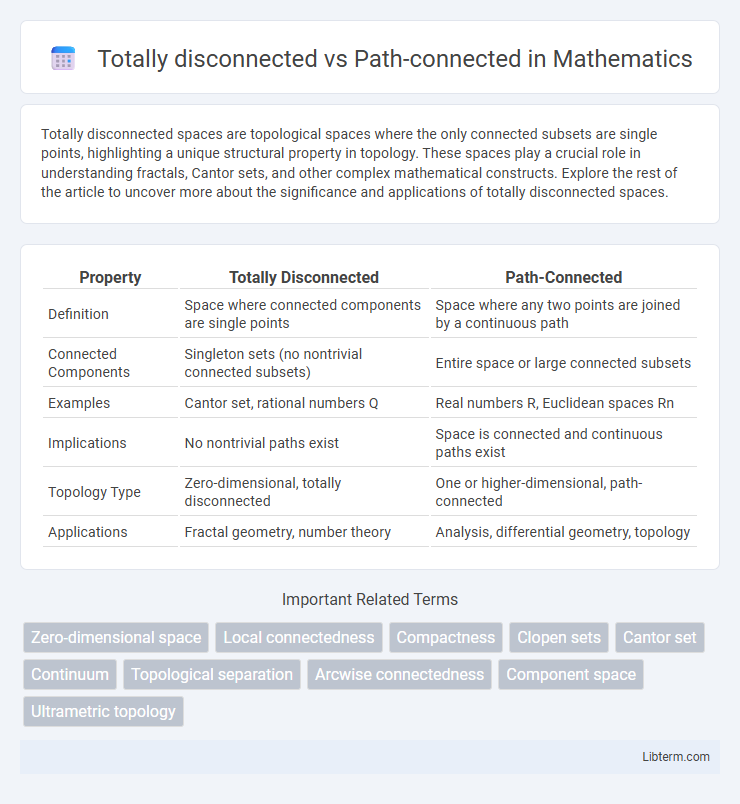Totally disconnected spaces are topological spaces where the only connected subsets are single points, highlighting a unique structural property in topology. These spaces play a crucial role in understanding fractals, Cantor sets, and other complex mathematical constructs. Explore the rest of the article to uncover more about the significance and applications of totally disconnected spaces.
Table of Comparison
| Property | Totally Disconnected | Path-Connected |
|---|---|---|
| Definition | Space where connected components are single points | Space where any two points are joined by a continuous path |
| Connected Components | Singleton sets (no nontrivial connected subsets) | Entire space or large connected subsets |
| Examples | Cantor set, rational numbers Q | Real numbers R, Euclidean spaces Rn |
| Implications | No nontrivial paths exist | Space is connected and continuous paths exist |
| Topology Type | Zero-dimensional, totally disconnected | One or higher-dimensional, path-connected |
| Applications | Fractal geometry, number theory | Analysis, differential geometry, topology |
Introduction to Topological Connectedness
Topological connectedness distinguishes spaces where any two points can be joined by a continuous path, known as path-connectedness, from totally disconnected spaces, which lack nontrivial connected subsets beyond singletons. Path-connected spaces are essential in analysis and geometry due to their unified structure, while totally disconnected spaces appear in fractal geometry and Cantor sets, exhibiting extreme separation properties. Understanding these concepts provides foundational insights into the continuity and structure of topological spaces in mathematical topology.
Defining Totally Disconnected Spaces
Totally disconnected spaces are topological spaces in which the only connected subsets are singletons, meaning no set containing more than one point is connected. These spaces contrast sharply with path-connected spaces, where any two points can be joined by a continuous path lying entirely within the space. Examples of totally disconnected spaces include the Cantor set and the rational numbers with the standard topology, emphasizing their fragmented structure without connected paths.
Understanding Path-Connected Spaces
Path-connected spaces feature a continuous path between any two points, ensuring that the space is a single piece without separations. In contrast, totally disconnected spaces lack such paths, consisting entirely of isolated points or sets with no continuous connection. Understanding path-connectedness aids in analyzing the topological structure and the coherence of spaces in fields like algebraic topology and geometric analysis.
Key Differences: Totally Disconnected vs Path-Connected
Totally disconnected spaces contain no non-trivial connected subsets, meaning each point forms its own connected component, while path-connected spaces allow any two points to be joined by a continuous path. In topology, totally disconnected spaces like the Cantor set exhibit fractal structures with isolated points, contrasting with path-connected spaces such as intervals in \(\mathbb{R}\) where paths ensure a continuous curve between points. The key difference revolves around connectivity properties: totally disconnected spaces lack continuous paths linking distinct points, whereas path-connected spaces guarantee the existence of such paths.
Examples of Totally Disconnected Spaces
Examples of totally disconnected spaces include the Cantor set and the set of rational numbers with the standard topology. The Cantor set is a classic fractal demonstrating total disconnection, where no subset containing more than one point is connected. The rational numbers form a dense subset of the real line but remain totally disconnected because between any two rationals lies an irrational, preventing path-connected intervals.
Illustrative Examples of Path-Connected Spaces
The unit interval [0,1] exemplifies a path-connected space where any two points can be joined by a continuous path, illustrating seamless connectivity. The Euclidean space \( \mathbb{R}^n \) is another classic example, inherently path-connected due to straight-line segments between points serving as continuous paths. Contrastingly, the Cantor set displays a totally disconnected space, lacking any nontrivial path, which highlights the fundamental difference in topology between path-connected and totally disconnected spaces.
Real-World Applications and Relevance
Totally disconnected spaces, such as the Cantor set, are crucial in digital signal processing and fractal analysis, where isolated points represent discrete states or data points. Path-connected spaces, exemplified by continuous curves and surfaces, are fundamental in robotics and navigation systems, ensuring seamless motion planning and obstacle avoidance. Understanding the distinction influences the design of algorithms in network topology, geographic information systems, and material science for modeling connectivity and fragmentation.
Mathematical Properties and Implications
Totally disconnected spaces contain no connected subsets besides single points, emphasizing isolated elements and fractal-like structures crucial in topology and measure theory, while path-connected spaces ensure a continuous curve between any two points, supporting the analysis of continuous functions and homotopy theory. Totally disconnected spaces often arise in studies of Cantor sets and p-adic numbers, revealing complex local geometry without global connectedness. Path-connectedness implies connectedness and facilitates the use of fundamental groups and covering space theory, significantly impacting algebraic topology and manifold analysis.
Counterexamples and Special Cases
Totally disconnected spaces contain no connected subsets with more than one point, exemplified by the Cantor set, which is uncountably infinite yet has zero path-connected components. Path-connected spaces, such as intervals in the real line, allow any two points to be joined by a continuous path, but certain fractals like the Sierpinski triangle defy simple characterization by possessing dense collections of both connected and disconnected subsets. Special cases include topological groups where local connectedness differs from total disconnectedness, highlighting nuanced behaviors beyond standard connectedness definitions.
Summary and Further Reading
Totally disconnected spaces consist entirely of points that cannot be connected through any non-trivial path, exemplified by the Cantor set, while path-connected spaces contain continuous paths between any two points, such as intervals in real numbers. Understanding the distinctions between these topological properties is crucial for analyzing the structure and behavior of different spaces in topology and related fields. For further reading, consult "Topology" by James Munkres or research articles focusing on connectedness and continuity in mathematical topology journals.
Totally disconnected Infographic

 libterm.com
libterm.com